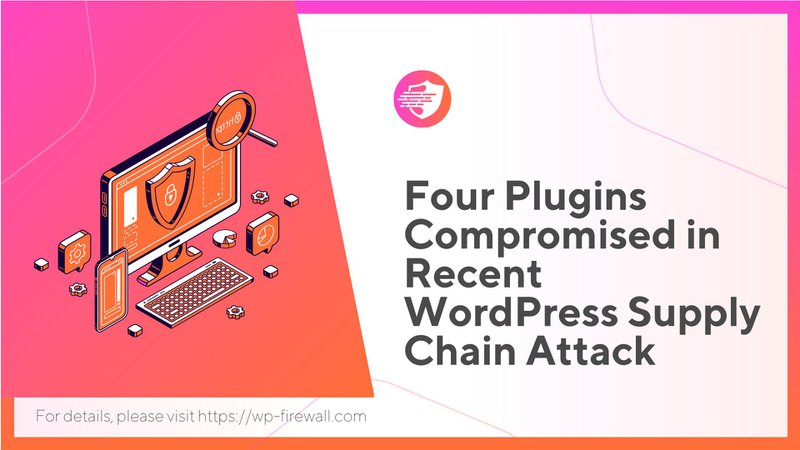
Introduction:
In the ever-evolving landscape of cybersecurity, WordPress sites have become prime targets for various forms of attacks. One of the most concerning recent trends is the rise of supply chain attacks. These attacks exploit vulnerabilities in the development and distribution process of software, leading to widespread and often undetected infiltration of malicious code. A recent incident, where compromised developer passwords led to the infection of several WordPress plugins, underscores the critical need for heightened security measures. As an authoritative source on WordPress security, WP Firewall delves into the nature of these attacks, the affected plugins, and essential security measures to protect your site.
Understanding the Supply Chain Attack
Supply chain attacks exploit weaknesses within the software development and distribution process. By targeting the source – such as developers or the infrastructure they use – attackers can introduce malicious code that propagates widely, often going unnoticed until significant damage has been done. In the recent WordPress incident, attackers gained access to developers’ environments through compromised passwords. This allowed them to inject harmful code into plugin updates, which were then distributed through the official WordPress repository.
Among the plugins affected were those widely used for various functionalities, making the attack particularly far-reaching. The nature of these attacks makes them especially dangerous because they exploit trust relationships within the software supply chain. When users download updates from what they believe to be a trusted source, they inadvertently install compromised code, exposing their sites to potential data breaches, defacement, or other malicious activities.
Among the plugins affected were:
- Advanced Custom Fields: A popular plugin used to add custom fields to WordPress edit screens.
- WP Reset: A tool for resetting the WordPress database to default values without modifying files.
- Duplicate Page: Used to duplicate posts, pages, and custom post types in WordPress.
- WP Database Reset: Provides the ability to reset the WordPress database back to its default state without reinstalling WordPress.
More About the Affected Plugins
- Advanced Custom Fields:Purpose: This plugin is essential for adding custom fields to WordPress posts, pages, and custom post types. It allows developers to create custom meta boxes and fields, enabling a highly customizable content management system.
Features: Provides a user-friendly interface for adding custom fields, supports various field types (text, image, file, etc.), and integrates seamlessly with the WordPress editor.
Use Cases: Ideal for creating complex forms, custom post types, and extending WordPress functionality for unique website requirements. - WP Reset:Purpose: WP Reset helps developers and site administrators quickly reset the WordPress database to default settings without affecting the core files. It is useful for testing and development purposes.
Features: One-click reset, selective reset options, snapshots for restoring previous states, and support for WP-CLI commands.
Use Cases: Commonly used in staging environments to quickly reset databases, clean up after extensive testing, or prepare for a fresh start during development. - Duplicate Page:Purpose: This plugin simplifies the process of duplicating pages, posts, and custom post types. It is particularly useful for creating drafts or templates based on existing content.
Features: One-click duplication, compatibility with custom post types, and options for managing duplicate content.
Use Cases: Frequently used by content creators to clone existing pages for consistent layout and formatting, facilitating quicker content creation and management. - WP Database Reset:Purpose: Similar to WP Reset, this plugin allows users to reset the WordPress database to its default state without the need for a complete reinstallation. It is designed for convenience and speed.
Features: Selective reset options, quick reset functionality, and support for resetting specific database tables.
Use Cases: Useful for developers who need to reset their database frequently during development cycles or testing phases.
The Implications for WordPress Security
The implications of supply chain attacks extend beyond the immediate damage to individual sites. They threaten the integrity of the entire WordPress ecosystem. Trust in the plugin repository is paramount, and such breaches can erode confidence among users and developers alike. This particular incident highlights several critical areas for concern:
- Developer Security Practices: The necessity for developers to adopt stringent security measures, including robust password policies and the use of multi-factor authentication (MFA).
- Integrity of the Repository: Ensuring that the WordPress plugin repository maintains high standards for vetting and monitoring submitted plugins and updates.
- User Vigilance: Users must be aware of the potential risks associated with third-party plugins and take proactive steps to secure their sites.
The broader implications also include the need for more comprehensive security frameworks that can detect and mitigate such attacks before they affect end-users. This means not only improving technical defenses but also fostering a culture of security awareness and best practices within the WordPress community.
Proactive Measures to Prevent Attacks
Preventing supply chain attacks requires a multifaceted approach that involves both developers and users. Here are some critical proactive measures that can significantly reduce the risk of such attacks:
- Regular Updates: Keeping all software, including WordPress core, plugins, and themes, up to date is one of the most effective ways to mitigate security vulnerabilities. Developers frequently release updates that patch known issues, and applying these updates promptly can prevent exploits.
- Strong Password Practices: Implementing strong, unique passwords for all accounts associated with WordPress sites, including admin accounts, hosting accounts, and development environments. Using a password manager can help manage complex passwords.
- Two-Factor Authentication (2FA): Enabling 2FA adds an additional layer of security. Even if an attacker manages to obtain a password, they will still need a second form of verification to gain access.
- Code Reviews and Audits: Regularly reviewing and auditing code, especially for custom plugins and themes, can help detect malicious code or vulnerabilities before they are exploited. This is particularly important for plugins obtained from third-party sources.
- Use Trusted Sources: Only download plugins and themes from reputable sources, such as the official WordPress repository or well-known developers. Be cautious with plugins that have not been updated for a long time or those with limited reviews.
- Security Plugins: Installing security plugins that offer features like malware scanning, firewall protection, and real-time threat intelligence can provide an additional layer of defense against various types of attacks, including supply chain attacks.
Innovative Security Solutions from WP Firewall
WP Firewall is at the forefront of providing advanced security solutions designed to protect WordPress sites from sophisticated threats, including supply chain attacks. Our comprehensive suite of features includes:
- Malware Scanning: Our real-time malware scanning capabilities detect and remove malicious code before it can cause harm. By continuously monitoring your site for unusual activity, we can quickly identify and mitigate threats.
- Firewall Protection: Advanced firewall rules block malicious traffic and prevent unauthorized access. Our firewall is designed to adapt to emerging threats, providing robust protection against various attack vectors.
- Real-Time Threat Intelligence: We leverage real-time threat intelligence to stay ahead of potential security threats. Our systems are continuously updated with the latest information on new vulnerabilities and attack patterns, ensuring your site is protected against the latest threats.
- Automatic Updates: WP Firewall ensures that all security features are always up to date, providing seamless updates that enhance your site's defenses without any manual intervention.
- Comprehensive Security Reports: Detailed security reports provide insights into your site's security status, helping you understand potential vulnerabilities and the effectiveness of the measures in place.
- User-Friendly Interface: Our intuitive interface makes it easy for users of all technical levels to manage their site's security. We provide clear guidance and actionable recommendations to help you maintain a secure WordPress environment.
Conclusion
Maintaining robust security practices is essential to safeguard against supply chain attacks and other cyber threats. The recent incident involving compromised developer passwords and infected plugins serves as a stark reminder of the importance of proactive security measures. By adopting the best practices outlined above and leveraging the comprehensive security solutions offered by WP Firewall, WordPress site owners can ensure their sites remain secure and trustworthy.
Stay Updated and Secure: Protect your WordPress Site by WP-Firewall today without credit card! Sign up for our newsletter to receive the latest security updates, tips, and insights directly to your inbox. Stay one step ahead of potential threats with WP Firewall. Your security is our priority, and together, we can build a safer WordPress ecosystem.

